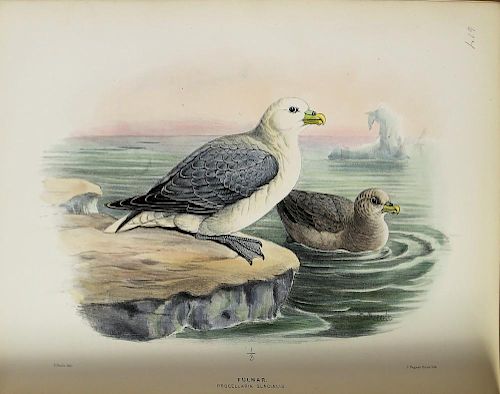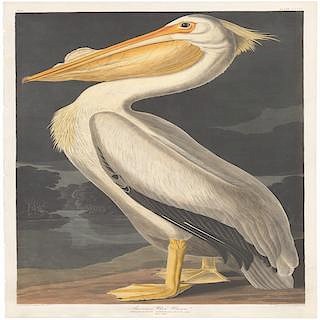Birds of Europe, Dresser, Rare Book
Lot 127
About Seller
Arader Galleries
1308 Walnut Street
King of Prussia, PA 19406
United States
Arader Galleries proudly celebrates over 40 years in the business of important, antique works on paper, paintings and rare books. W. Graham Arader III began his collection of rare maps, atlases and Americana while an undergraduate at Yale University, and today that passion has grown into one of the ...Read more
Estimate:
$8,000 - $15,000
Absentee vs Live bid
Two ways to bid:
- Leave a max absentee bid and the platform will bid on your behalf up to your maximum bid during the live auction.
- Bid live during the auction and your bids will be submitted real-time to the auctioneer.
Bid Increments
| Price | Bid Increment |
|---|---|
| $0 | $25 |
| $500 | $50 |
| $1,000 | $100 |
| $2,000 | $250 |
| $5,000 | $500 |
| $10,000 | $1,000 |
| $20,000 | $2,000 |
| $50,000 | $5,000 |
| $100,000 | $10,000 |
| $200,000 | $25,000 |
About Auction
By Arader Galleries
Mar 25, 2017 - Mar 26, 2017
Set Reminder
2017-03-25 13:00:00
2017-03-26 13:00:00
America/New_York
Bidsquare
Bidsquare : Arader Galleries Spring 2017 Auction
https://www.bidsquare.com/auctions/arader/arader-galleries-spring-2017-auction-2184
Arader Galleries loricohen@aradergalleries.com
Arader Galleries loricohen@aradergalleries.com
- Lot Description
A History of the Birds of Europe including all the species inhabiting the Western Palaearctic Region. Henry E. Dresser (1838-1915) - J. G Keulemans (1842-1912). London: Printed by Taylor and Francis for the author, 1871-1881. Volume IX: Supplement. London: Taylor & Francis for the author, 1895-96. Physical Description: 9 volumes. Quarto (12 4/8 x 10 inches). The Preface, Introduction, List of Subscribers and Index bound as volume I. 723 lithographed plates, with one unlisted in original hand color, 2 uncolored plates, plates numbered in manuscript Volume II-VIII, some annotations in the text, some illustrations in the text, Volume IX plates misbound, 634-639, 641, 640, 642-707, 709, 708, 710-722. Drawings after J.G. Keulemans, Joseph Wolf and E. Neale, the coloring by Smith and W. Hart. Green half morocco, gilt, top edges gilt, 6 compartments with 5 raised bands. An important monograph, A History of the Birds of Europe is one of three major monographs published by Dresser. Still the largest and most complete work on this subject. The others are his A Monograph of the Meropidae, or Family of the Bee-Eaters, 1884-1886, and A Monograph of the Coraciidae, 1893. All of these works contain illustrations by Keulemans. Dresser was also the author of over 100 scientific papers on birds, mostly concerned with geographical distribution and new species. His Manual of Palaearctic Birds (1902) was an important contribution to the delimitation of the ranges of Palaearctic birds. The principal artist Johannes Gerardus Keulemans (1842-1912), began his career as a taxidermist providing stuffed birds to the State Museum of Natural History at Leiden. The director of that museum encouraged Keulemans to pursue his love of natural history, where he obtained a scientific appointment after an expedition to West Africa in 1865 and 1866. His accomplishments in illustration came to the notice of Richard Bowdler Sharpe, later a director of the British Museum, who encouraged him to move to England. Keulemans quickly achieved wide recognition and established himself as the most popular bird artist of the late Victorian period. He regularly provided illustrations for The Ibis and The Proceedings of the Zoological Society. He illustrated many important bird books as well as those by Dresser, including Buller’s A History of the Birds of New Zealand (1873), Shelley’s Monograph of the Sun-Birds (1876-1880), William Vincent Legge’s Birds of Ceylon (1880), Daniel Giraud Elliot’s Monograph of the Hornbills (1887-1892) and many others. Keulemans has painted remarkable pictures of extinct birds, like the Choiseul Crested Pigeon, Kangaroo Island Emu, Huia, Stephens Island Wren, Hawaii Oo, Hawaii Mamo, Oahu Oo, Guadalupe Petrel, and the Laughing Owl. All these paintings can be seen in the American Museum of Natural History in New York. A leading figure in ornithological circles Henry Eeles Dresser was elected as a Member of the British Ornithologists’ Union in 1865 and served as its secretary from 1882 to 1888. He was also a member and fellow of the Linnean and Zoological societies of London and an honorary fellow of the American Ornithologists’ Union. He was a close friend of Professor Alfred Newton, Thomas Littleton Powys, 4th Baron Lilford and of Sir Alfred Russel Wallace. He knew all of the leading ornithologists of the day. He was particularly well-known to European, American and Russian ornithologists. He worked with Alfred Newton on the promotion of a “close time” for British birds, a period, during 1862, when birds could not be hunted. This early effort aided in the commencement of the bird conservation movement. In spite of Keulemans’ prominence as an ornithologist, this activity had to come second to his business which, from 1870 until 1910, was in iron, with premises at 110 Cannon Street in The City. Dresser left England in 1912 in order to live in Cannes for the benefit of his health; he died in Monte Carlo. Jackson 94; Anker 120; Nissen IVB, 267. Guidance: Christie’s, 1999 - $23,891
- Shipping Info
-
Shipping Terms:Packing and handling of purchased lots by us or by someone else is at the entire risk of the purchaser. Purchasers are responsible for all packing and shipping costs.
We are not responsible for the acts or omissions of carriers or packers of purchased lots whether or not recommended by us.
-
- Buyer's Premium



 EUR
EUR CAD
CAD AUD
AUD GBP
GBP MXN
MXN HKD
HKD CNY
CNY MYR
MYR SEK
SEK SGD
SGD CHF
CHF THB
THB






